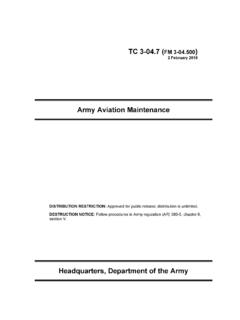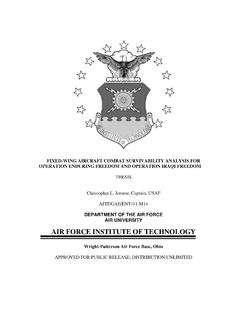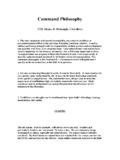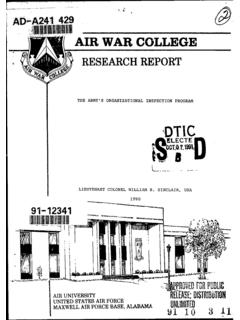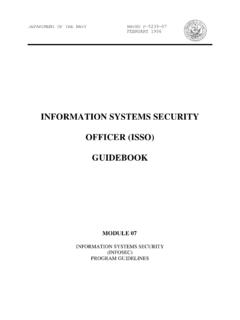Transcription of BY ORDER OF THE AIR FORCE INSTRUCTION 13 …
1 BY ORDER OF THE SECRETARY OF THE AIR FORCE AIR FORCE INSTRUCTION 13-204, VOLUME 4 18 JANUARY 2017 Space, Missiles, command and Control MANAGEMENT OF GROUND RADAR AND AIRFIELD SYSTEMS COMPLIANCE WITH THIS PUBLICATION IS MANDATORY ACCESSIBILITY: Publications and forms are available on the e-Publishing website at for downloading or ordering. RELEASABILITY: There are no releasability restrictions on this publication. OPR: HQ AFFSA/XM Supersedes: AFI 13-216, 5 May 2005 Certified by: HQ USAF/A3X (Mr. Steven A. Ruehl) Pages: 91 This publication implements AFPD 13-2, Air Traffic Control, Airspace, Airfield, and Range Management. It applies to all Air FORCE , Air National Guard (ANG) and Air FORCE Reserve command (AFRC) 1C8 Ground Radar/Airfield Systems career fields (to include DoD and contract civilians). It directs the management of US Air FORCE (USAF), Air National Guard (ANG) and Air FORCE Reserve command (AFRC) airfield operations personnel (to include DoD and contract civilians) and describes career development.
2 It specifies minimum administrative, procedural and operational performance and management standards for services provided by all USAF Airfield Operations (AO) facilities, including contracted AO locations where the USAF has functional oversight responsibility. This Air FORCE INSTRUCTION (AFI) may be supplemented at any level, however all supplements to include interim changes to previously approved supplements must be routed to Headquarters (HQ) Air FORCE Flight Standards Agency, Director of Air Traffic Control and Landing Systems (ATCALS) Maintenance and Policy (HQ AFFSA/XM) for coordination prior to certification and approval. The authorities to waive wing/unit level requirements in this publication are identified with a Tier ( T-0, T-1, T-2, T-3 ) number following the compliance statement. See AFI 33-360, Publications and Forms Management, Table for a description of the authorities associated with the Tier numbers.
3 Submit requests for waivers through the chain of command to the appropriate Tier waiver approval authority, or alternately, to the Publication OPR for non-tiered compliance items. Refer recommended changes and questions about this publication to the Office of Primary Responsibility (OPR) using the AF Form 847, Recommendation for Change of Publication; route AF Form 847s from the field through Major command (MAJCOM) functional chain of command . Ensure that all records created as a result of processes prescribed in this publication 2 AFI13-204V4 18 JANUARY 2017 are maintained in accordance with (IAW) Air FORCE Manual (AFMAN) 33-363, Management of Records, and disposed of IAW Air FORCE Records Disposition Schedule (RDS) located in the Air FORCE Records Information Management System (AFRIMS). The use of the name or mark of any specific manufacturer, commercial product, commodity, or service in this publication does not imply endorsement by the Air FORCE .
4 See Attachment 1 for a glossary of references and supporting information used in this INSTRUCTION . Chapter 1 OVERVIEW 7 7 Scope.. 7 Waivers and Recommended Changes.. 7 Terms and Definitions.. 8 Responsibilities.. 8 Contract Maintenance.. 8 Chapter 2 RESPONSIBILITIES 10 HQ A3.. 10 HQ Air FORCE Flight Standards Agency (AFFSA).. 10 MAJCOM HQ.. 10 Unit Commander.. 11 Superintendent/Chief of Maintenance (where applicable according to local OSS organizational structure).. 11 Maintenance Work Center Supervisors/Branch Chief.. 12 Chapter 3 PRODUCTION WORK CENTER 13 Introduction .. 13 Responsibilities of the Production Work 13 Work Center Supervisors will:.. 15 Critical Outage Reporting.. 16 Table Critical Outage Reports Equipment List.. 16 Table Critical Outage Report (COR) Template.. 17 Suggested Annual Reading List. Note: .. 17 Facility Requirements.. 18 AFI13-204V4 18 JANUARY 2017 3 Facility Records.
5 18 ATCALS Maintenance Special Considerations For Removing NAVAID Identification Signals.. 19 ATCALS Facility Reference Data.. 19 Non-ATCALS Equipment.. 19 Work Center Duties and Responsibilities for Remotely Maintained Equipment.. 19 Chapter 4 MOBILITY WORK CENTER 21 Introduction.. 21 Scope.. 21 Deployed Site Commander Duties and Responsibilities.. 21 Maintenance Operation Center Function Responsibilities.. 21 Inspections and Evaluations (I&E).. 22 Materiel Control.. 23 Team Lead.. 23 Chapter 5 REGIONAL MAINTENANCE CENTER 25 Introduction.. 25 MAJCOM Duties and Responsibilities.. 25 HQ AFFSA/XM Duties and Responsibilities.. 25 RMC Positions Duties and Responsibilities.. 26 Regional Maintenance (RM) Work Center Duties and Responsibilities.. 30 AFETS/SMT Work Center Duties and 31 ATCALS Radar Evaluation Work Center Duties and Responsibilities.. 31 Chapter 6 SYSTEM MANAGERS 33 Introduction.. 33 Duties and Responsibilities.
6 33 LCSM Points of Contact.. 34 Chapter 7 INSPECTIONS AND EVALUATIONS 35 Introduction.. 35 Roles and Responsibilities.. 35 4 AFI13-204V4 18 JANUARY 2017 Self-Inspection/Assessment Program.. 35 Managerial Evaluations (ME).. 35 Personnel Evaluations (PE).. 35 Equipment Evaluations (EE).. 39 UTC Evaluations.. 39 Chapter 8 WORK CENTER SAFETY 41 Introduction.. 41 Lockout/Tag Out (LOTO).. 41 Electrostatic Discharge (ESD).. 41 Additional Requirements.. 41 Ground and Lightning Protection.. 41 Climbing.. 41 Chapter 9 TRAINING MANAGEMENT 42 Introduction.. 42 Program Responsibilities.. 42 Climbing Training Requirements.. 42 Chapter 10 LOGISTICS, LIFE CYCLE AND PROJECT MANAGEMENT 43 Introduction.. 43 Air FORCE Centrally Supported Equipment/Systems.. 43 Non-Centrally Supported Equipment/Systems.. 43 Life Cycle Management Plans.. 43 MAJCOM Responsibilities.. 44 Base/Unit Responsibilities.
7 44 Work Center Supervisor.. 44 Modification Management.. 46 Chapter 11 MATERIEL MANAGEMENT 47 Introduction.. 47 Logistics Readiness Squadron (LRS) Liaison.. 47 General Materiel Management.. 48 AFI13-204V4 18 JANUARY 2017 5 Chapter 12 TECHNICAL ORDER MANAGEMENT 51 Introduction.. 51 Work Center/Section/UTC Publication Management.. 51 Technical Manual (TM) Distribution and Control.. 51 Local Work cards Sets (LWCS).. 51 TCI Management.. 52 FAA Technical Manual Management.. 53 53 Air FORCE Maintenance Special Instructions (AFMSI).. 55 Chapter 13 TMDE AND TOOLS MANAGEMENT 57 Introduction.. 57 General TMDE Requirements.. 57 General Tool Requirements.. 58 Work Center Tool Management.. 58 Chapter 14 CORROSION PREVENTION AND CONTROL PROGRAM (CPCP) 61 Introduction.. 61 Production Work Center Responsibilities.. 61 Chapter 15 HISTORICAL RECORD MANAGEMENT 62 Introduction.. 62 Overview.. 62 Work Center Responsibilities.
8 63 Completion of AFTO Form 95, Significant Historical Data.. 67 Historical Records.. 67 6 AFI13-204V4 18 JANUARY 2017 Attachment 1 GLOSSARY OF REFERENCES AND SUPPORTING INFORMATION 70 Attachment 2 PERSONNEL EVALUATION REPORT WRITING AND SUBMISSION 83 Attachment 3 ANTENNA PREVENTIVE MAINTENANCE INSPECTION PROCEDURES 87 Attachment 4 SAMPLING PLAN 88 Attachment 5 AIR FORCE MAINTENANCE QUALITY CONTROL CHECKLIST (AFMQCC) 90 Attachment 6 ATCALS/DATCALS AFMSIS 91 AFI13-204V4 18 JANUARY 2017 7 Chapter 1 OVERVIEW Purpose. The purpose of this INSTRUCTION is to establish procedures for the maintenance management of ground radar and airfield systems equipment. Scope. This INSTRUCTION applies to the 1C8 Ground Radar/Airfield Systems career fields working on ground radar/airfield systems equipment unless exempted by the career field functional manager. It also applies to any organization with production responsibilities for ground radar and airfield systems/equipment and processes unless exempted by the appropriate AF-level functional manager.
9 This includes all Air FORCE (AF) military and civilian personnel, members of the Air FORCE Reserve command (AFRC), Air National Guard (ANG), and AF contractors. The procedures and practices listed in this INSTRUCTION are established by Department of Defense (DoD), Air FORCE Instructions, Air FORCE Occupational Safety and Health (AFOSH), and other guidance. Note: Units using AF contractors will follow guidance provided in paragraph , Contract Maintenance. Maintenance Objective. The primary objective of maintenance is to ensure continued operational availability of systems and equipment used to support the Air FORCE mission. A key factor in achieving this objective is maintenance discipline. Maintenance discipline involves integrity in all aspects of the maintenance process. It is the responsibility of all personnel to comply with all written guidance to ensure required repairs, inspections, and documentation are completed in a safe, timely and effective manner.
10 Managers must establish a climate that promotes maintenance discipline. Depth of Maintenance. Technology is constantly changing and traditional maintenance concepts must be adapted to the new environment. The depth and breadth of these concepts will vary considerably across the maintenance complex. Normally, older systems will be more maintenance intensive, than newer equipment sustained under the Line Replaceable Unit (LRU) replacement concept. Readiness Expectations. Readiness requirements may cause deferment of essential maintenance or training. Failure to recognize and support valid requirements might cause maintenance backlogs or mission failure. Managers must ensure every action is taken to make systems available for required maintenance actions and ensure maintenance is completed to meet mission requirements. Waivers and Recommended Changes. Waiver Authority.










